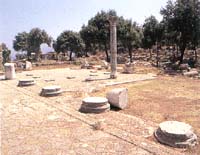(Roman-Byzantine Remains and Resort 18 km)
The sudden dramatic height of Mount Lebanon gives Beit Mery, at 800 meters, spectacular views of the Beirut peninsula and large sections of the coast. This is a popular resort with good restaurants, entertainment and hotels ready to receive visitors. The town is also the scene of an annual winter cultural festival that features international drama and dance groups as well as orchestras and chamber ensembles.

At the top are the ruins of a Roman temple to the important local god Baal Marqod which has a church built on part of its foundations. The church, dedicated to Saint John the Baptist was constructed in 1750 and has apparently been rebuilt a number of times since then. The inscription above the main door bears the date 1768, the year the church was first built. The old church is incorporated into the present early 20th century structure.
The temple itself, probably dating to the first century AD, has masonry intact up to three meters. Three of the six columns are still standing, although not at their original height.
A short walk down the hill leads to the site of a small second century AD temple to the goddess Juno. A monumental doorway still stands amid a jumble of ancient stones, some with Latin inscriptions. This door-way was probably the start of a processional path between the two temples.
Below the Juno temple is an extensive area of scattered ruins. Of particular note is the mosaic floor of a 6th century Byzantine church with one of the reused temple columns in place. Nearby is a remarkably well preserved public bath. In one of its rooms it is possible to observe the heating system through a hole broken in the floor. The hypocaust tiles, used to conduct heat, are all in place.
Once a Roman-Byzantine settlement, the entire site is littered with remains of more temples, a second bath and a colonnaded street.
(BYBLOS - JEITA GROTTO - TRIPOLI - SIDON - ZAHLÉ - BAALBECK)
(THE CEDARS - TYRE - BEITEDDINE - AANJAR)
EGYPT - SYRIA - JORDAN